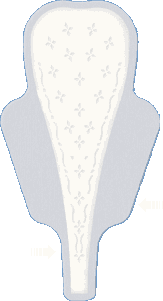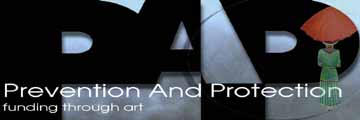|
|
Bust magazine loves me!
Bust, "The voice of the new girl order," published in
New
York City, made its cover story "Men We Love," and I'm
one of
'em, because of this museum. (It later folded, I hope
not because of me.)
Many thanks, Bust! I'm flattered to be in such fast
company. I've loved
magazines all my life and now, one loves me!
23 September I'm in Hollywood; next update is 1
October
A woman is challenging my running this Web site and
future physical
museum (because I'm a man) on an episode of a new
television program, Moral
Court, starting in the fall in the U.S.A. We're also
debating some other
menstruation issues. Warner Brothers tapes it Saturday,
23 September.
I'll tell all if this
indeed takes place
(it did). Some site visitors
may remember that
a "Roseanne" TV show that was to include a guided tour
of the
physical Museum of Menstruation was canceled the day
before; the same thing
happened to an appearance of board member Miki Walsh and
myself in January
on the quiz-show revival "I've Got a Secret" on the new
Oxygen
network.
Darn it! Why didn't someone tell me it's hard to break
into show biz
when your shtick is menstruation?
Letters to your MUM
When did people discover the
ovulation cycle?
Hi.
I'm trying to find out when society knew about the
ovulation cycle. Specifically, whether ancient Near-East
societies between about 2,000 BCE and 200 BCE
understood anything about the ovulation cycle.
I know your museum is about menstruation, but I
thought perhaps you could help me find this out.
This is connected with the
biblical instructions about telling the difference
between a normal menstrual flow and an unnatural
flow that might be due to illness. [Read some biblical mentions of vaginal
bleeding.]
Any guidance you can give would be most
appreciated! [Mail
me and I will forward it.]
Thanks,
What are the odds of getting two letters about menstruation spoiling tomatoes
in one week?
You can't can tomatoes
during your period in southern Italy!
Hello again, Harry,
[Her name] here, your Italian Web site admirer
and friend from Seattle. :-)
I have another interesting M[useum] of
M[enstruation] tidbit for you.
My sister was in Italy visiting our parents
for three weeks this August. She was there at a
time when the tomatoes had ripened and all the
women in our town make and can tomato sauce.
Well, my poor sister got suckered into helping
not just my mom, but two other women making the
sauce. And why, you ask?
Because these women's daughters were having
their periods and you can't help can tomatoes
while you're having your period! It
will affect their acidity [the tomatoes', not
the women's] or something like that. Ain't that
a hoot?? The women of Italy seriously believe
this. Mind you, this is southern Italy, they're
a lot more superstitious there. [There are many
similar beliefs in the world today, including
the United States.]
Well, that was it.
Best regards,
An American grandmother
warned his wife not to can tomatoes while
menstruating!
Dear sirs,
Let me put this as delicately as I can.
My wife, a well-educated woman of 38 years.,
still remembers her grandmother's advice in the
kitchen. She also remembers
her advice to never can tomatoes while she is
menstruating, believe it or not! I
realize that this is a ridiculous notion, but what
I was wondering is if you in all your research
have come across this "taboo"? I suppose that
there could have been a "genuine" reason for this
tactic hundreds of years ago, but how this myth
survived to the recent day is beyond me! Have you
ever heard of this or something similar? Do you
have any historical documentation of this
practice? Please let me know at your earliest
convenience, if possible.
Thanks in advance!
[This and similar beliefs about about spoiling
food and ruining crops probably go back thousands
of years in Western society and were supported and
spread by respected writers. I don't know the
origins, which may be multiple, but they seem a
bit anti-woman.
[As Dr. Elsimar Coutinho writes in his recent
book Is Menstruation
Obsolete? (read about it),
as recently as 1952 Harvard researchers Olive and George Smith
maintained that there was a toxic substance in
menstrual blood - menotoxin
(read also today's humor page) - that killed
animals when menstrual blood was injected into
them. Another researcher showed that by using
antibiotics the animals survived, demonstrating to
most peoples' satisfaction that what killed the
animals was an infection caused by bacteria from
the vagina. Many bacteria grow very well in blood,
and the vagina normally contains good and harmful
bacteria, but the latter in small quantities;
blood can help increases their number.
[By the way, there has been at least one
doctoral dissertation about menotoxin: "Sulfur metabolism and
menstruation. A contribution to the question of
menstrual poison [menotoxin]," my
translation of "Schwefelstoffwechsel und
Menstruation. Ein Beitrag zur Frage des
Menstruationsgiftes," University of Munich, by
Walter Senninger, in 1926.]
The pad for thong underpants from Scandinavia
 |
Hello, it's me again, "14-year-old
Norwegian girl." [Read her last
letter, about Muslim girls.] Just
wanted to tell you about the latest sanitary
napkin in Scandinavia, for STRING
UNDERPANTS!!! It's true.
Here it is [she kindly e-mailed the
picture at left]. As you can see, it is
designed to fit string underpants, and is
meant to be used when having normal/little
menstrual flow. I think this is really
stylish! The company behind this invention
is Libresse, a part of the SCA Mölnlycke
company [read some history of the
company].
What do you say? My grandmother knitted
her sanitary napkins (!) [see Norwegian knitted
pads from the 19th century] and had to
wear a skirt because it was too easy to see
if she wore jeans - and now . . . well,
things change, that's for sure!
Love,
Norwegian girl
[Here's the site's first
report of the pad.]
|
Menstrual expressions and e-mail privacy
Dear Harry,
Yes, I think it's a phrase men use more than women
[the male writer sent She's
got the painters in as an addition to the
English menstrual words
list] - but I'm sure
you can find out for sure by asking on your site. [Anyone know?]
I will send along others as and when they occur to
me, though most phrases used in Britain seem to be
under the U.S.A. heading on your list.
I don't think my name adds anything to my
contribution, so don't post it, though I shall have
to do some deeper thinking about just why I say
that. [I don't put names or
addresses with mail, contributions, etc., unless
otherwise instructed, or unless it's obviously
desired, as in the case of a company. Menstruation
is a troubling subject for many people.]
What does o.b. mean?
Dear Reader,
I have a very urgent question. Does anybody know
what the meaning of the initials o.b. is? And who
the **** was so clever to not write it down in the
discription? Please help me and write me back soon.
Yours sincerely
[Six years ago I didn't know either and phoned
Johnson & Johnson, which owns the brand. After
one person after another hadn't the foggiest idea, I
reached a woman in the technical library. She
promised she would ask oldtimers who were there when
J & J bought the company from the German
company, Dr. Hahn GmbH.
[Two weeks later the librarian called back and
reported that someone said it stood for "ohne
Binde," which the she said meant "without a belt" in
German. Well, "Binde" looks like the English word
"bind," making us think of a belt, but it really
means "pad." So it means "without a pad," a tampon.
[So even J & J folks didn't know what it meant
in English, and almost not in German! Look at a
clever French ad for o.b.]

Pap art exhibit starts
21 September in Delray Beach, Florida
I am writing to request your participation and
assistance in an exciting and important project
regarding women's health issues.
The world-renowned scientist and lover of the arts
Dr. George Papanicolaou,
better known as Dr. Pap, inventor of the Pap smear
test, will be the subject of a special exhibition
at the Cornell Museum of Art in Delray Beach,
Florida, beginning September 21, 2000. The
gala opening and artist's reception will be held on
Thursday evening September 28, 2000. The foremost
patient advocate and director of the Center For
Cervical Health in the United States, Carol Ann
Armenti, will be the keynote speaker.
The exhibition will run through November 12, 2000,
and will feature recent works by international artist Olga
Stamatiou, Dr. Papanicolaou's niece.
Stamatiou's works will be available for acquisition
and the profits will go
toward:
1. The creation of "PAP MOBILES," vehicles that
would be used to provide testing for under-served
women in areas, with the highest incidence of
cervical cancer.
2. The creation of a traveling multimedia art
exhibition.
3. The production of a documentary film based on
the life, work and scientific legacy of Dr.
Papanicolaou and his wife Mary.
4. The Center for Cervical Health.
5. The Papanicolaou Woman's Corp.
Our organization "PAP" - Prevention and Protection
- will have as its goal to raise awareness about
women's health issues, including the importance of
having regular Pap smears and the provision of
information on new and existing methods for
detecting cervical cancer.
The traveling exhibition, to be viewed in public
spaces and museums, will be a multimedia environment
drawing on and inspired by Dr. Pap's love of the
arts and sciences. This environment will include
permanent built-in units that will provide creative
spaces for national and local women's health
organizations to inform women on what is available
involving health care.
The September 28th opening reception will also
include international guest artists and feature a
wide range of styles and media. A percentage of
their work will benefit the above-mentioned
projects.
Olympus Corporation of America will provide
working microscopes and monitors along with
technicians on opening night to demonstrate how Pap
smears are read.
Washable-pad company for sale
Gayle Adams, owner of
Feminine Options, wants to sell the company to
someone willing to put time and energy into it.
The Food and Drug Administration has already
approved its products.
Call Gayle at (715) 455-1652
(Wisconsin, U.S.A.).
|

